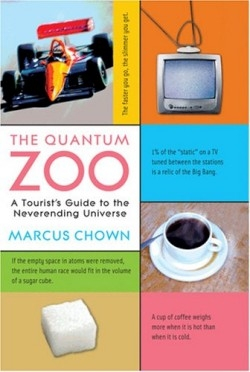
The Quantum Zoo
A Tourist's Guide to the Neverending Universe
Einstein’s general theory of relativity is arguably the greatest contribution to science by one human mind. The legendary physicist described his inspiration as the happiest thought of his life. Unfortunately, nearly a century later, almost no one outside the world of physics understands it. Even fewer have a grasp of quantum theory. This author, a cosmology consultant for the English magazine New Scientist and writer of the popular science books The Universe Next Door, Afterglow of Creation, and The Magic Furnace, wants to help. He believes that ordinary people can understand both quantum theory and Einstein’s general theory of relativity, which he calls “the two towering achievements of the past 100 years.” Chown’s results are mixed.
The author begins with a bang, offering the reader tidbits such as: “Every breath you take contains an atom breathed out by Marilyn Monroe,” and “You age faster at the top of a building than at the bottom,” as well as “The faster you travel, the slimmer you get.” He moves along rapidly with the concept that all matter—a chair, a human being, a star—is almost exclusively space. He provides the helpful visual image that if the empty space were squeezed out of all the atoms in our bodies, all of humanity would fit in the space occupied by a single sugar cube. That’s the easy part.
The difficulty comes with what Chown calls “the fundamental ungraspability of the microscopic world.” Famed physicist Richard Feynman is quoted as saying, “I think I can safely say that nobody understands quantum mechanics.” Explanations about worlds that can’t be seen—atomic activity, interstellar light waves—invite analogy, but when it comes to atomic particles, there’s just no direct parallel in the everyday world. Analogies are helpful only to a point, sometimes only to the person making the comparison. While cautioning that there are no short cuts to understanding, Chown takes on too much in too few pages.
Quantum Zoo is not the ordinary person’s definitive explanation of quantum theory or of Einstein’s general theory of relativity; nevertheless it is a commendable introduction to both, particularly to the microscopic world that can’t be seen, a world that’s governed not by laws but by unpredictability, random chance, and uncertainty. Readers will emerge with a greater appreciation for the very small and the very large, of how particles from the Big Bang remain connected across the universe, and with a renewed respect for the genius of Einstein, who, by applying his theory of relativity to the entire universe, created cosmology, the ultimate science.
Reviewed by
Jill Blue Lin
Disclosure: This article is not an endorsement, but a review. The publisher of this book provided free copies of the book to have their book reviewed by a professional reviewer. No fee was paid by the publisher for this review. Foreword Reviews only recommends books that we love. Foreword Magazine, Inc. is disclosing this in accordance with the Federal Trade Commission’s 16 CFR, Part 255.
